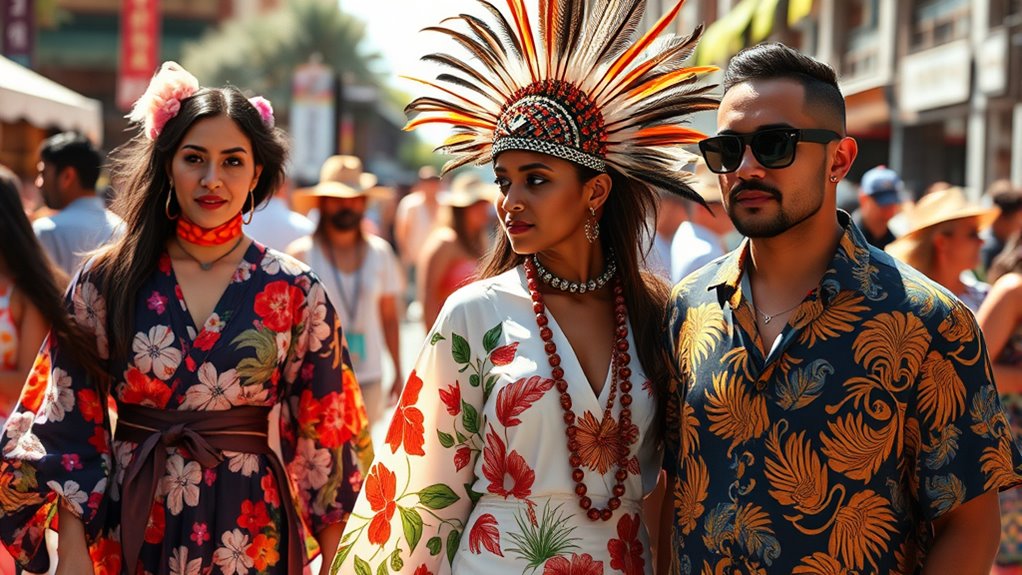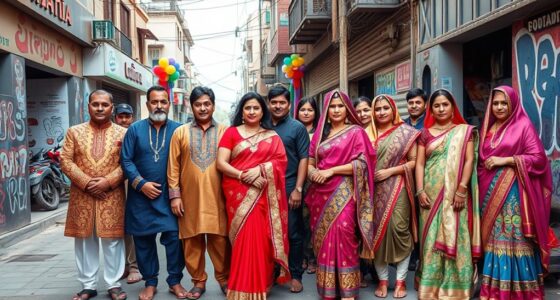To draw the line between cultural appreciation and appropriation in fashion, you should respect the cultural significance of symbols and traditional attire. acknowledge their origins, and collaborate authentically with communities. Avoid stereotypes and superficial trends—focus on understanding the deep meaning behind designs. Show reverence for sacred symbols and guarantee fair compensation. If you keep exploring these principles, you’ll better understand how to honor cultures respectfully while creating meaningful fashion.
Key Takeaways
- Appreciation involves respecting cultural origins, giving credit, and understanding the significance of elements, while appropriation disregards these aspects.
- Recognize the difference between honoring a culture and exploiting its symbols for personal or commercial gain.
- Engage with cultural communities authentically through collaboration and fair compensation to avoid misappropriation.
- Educate yourself on the history and meaning of cultural symbols before incorporating them into fashion.
- Be mindful of context, avoiding stereotypes or trivializing sacred symbols to ensure respectful cultural exchange.
Understanding Cultural Appreciation and Appropriation
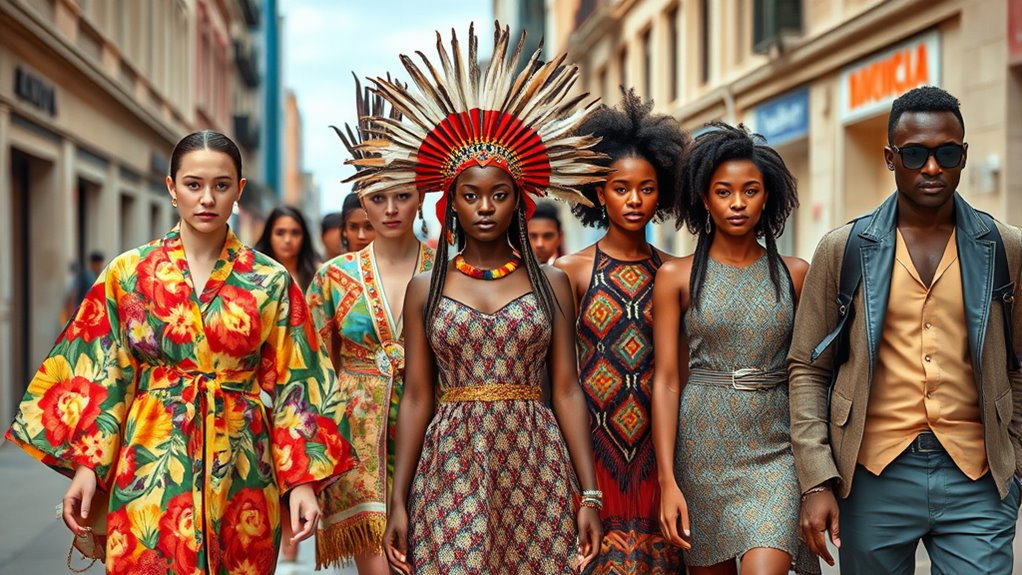
Understanding the difference between cultural appreciation and appropriation is essential when exploring fashion choices. Cultural stereotypes often influence how people perceive certain styles, leading to misconceptions about their origins. When you adopt cultural elements without understanding their significance, it can reinforce harmful fashion stereotypes and diminish their meaning. Appreciation involves respecting the cultural context, acknowledging its origins, and giving credit to the community. Appropriation, however, takes elements out of context for personal or commercial gain, often ignoring their cultural significance. Recognizing these differences helps you avoid perpetuating stereotypes or offending others. Being mindful ensures your fashion choices honor the culture’s true essence rather than reducing it to a trendy or exotic accessory. Additionally, understanding cultural symbolism and its proper use can further promote respectful appreciation rather than appropriation. Incorporating authentic cultural knowledge into your fashion choices demonstrates genuine respect for the traditions involved. Engaging with the local community can also provide valuable insights and foster appreciation rather than misappropriation.
Historical Context of Cultural Elements in Fashion

Understanding how cultural elements evolved in fashion helps you see their true significance. You’ll explore where traditional attire originated and how it has changed over time. Recognizing the colonial influence reveals how cultural exchange and power dynamics shaped these styles. Examining historical context can also shed light on how cultural appropriation versus appreciation is perceived today.
Cultural Significance Evolution
Throughout history, cultural elements in fashion have held deep significance, reflecting identities, beliefs, and social structures. Over time, these symbols have evolved alongside fashion trends, sometimes blending or diverging from their original meanings. As styles spread globally, the boundaries of cultural expression shifted, leading to debates about respect and authenticity. You might notice how certain designs once reserved for specific communities now appear in mainstream fashion, challenging traditional cultural boundaries. This evolution shows that cultural significance isn’t static; it adapts with society’s changing values and perceptions. Recognizing this progression helps you understand that fashion isn’t just about aesthetics but also about respecting the origins and meanings behind cultural elements. Additionally, incorporating authentic textiles and accessories thoughtfully can help honor cultural roots rather than appropriating them. Being aware of cultural symbolism in fashion can further guide you in making respectful choices. This awareness guides you to navigate cultural influences thoughtfully in your fashion choices.
Traditional Attire Origins
Traditional attire often embodies the historical roots and cultural identity of a community, serving as more than just clothing. These garments reveal the cultural origins of a group, reflecting centuries of tradition, beliefs, and social structures. When you explore traditional attire, you uncover stories of craftsmanship, symbolism, and regional influences that have been passed down through generations. Each element, from fabric choice to ornamentation, has a purpose rooted in history. Understanding the cultural origins behind these garments helps you appreciate their significance beyond fashion trends. Recognizing the deep historical context ensures that you respect the cultural importance of traditional attire, rather than viewing it as mere style. This awareness promotes appreciation grounded in knowledge of a community’s cultural heritage. Additionally, being aware of the symbolic meanings embedded in traditional garments fosters more respectful and informed engagement with cultural expressions. Appreciating the cultural significance of traditional attire encourages a more respectful approach and prevents misinterpretations or misappropriation of cultural symbols. Incorporating cultural context into your understanding ensures a more authentic and respectful appreciation of traditional clothing.
Colonial Influence Impact
Colonial encounters considerably reshaped the fashion elements of many cultures, often blending or replacing traditional styles with new influences. This colonial legacy resulted in cultural dominance, where colonial powers imposed their aesthetic standards and absorbed local designs into a broader, often Eurocentric, fashion narrative. As a result, many indigenous garments and motifs were altered or marginalized, leading to a loss of cultural identity. These historical influences continue to impact fashion today, with some designers drawing inspiration from colonial-era styles, sometimes without acknowledgment. Recognizing the colonial legacy helps you understand how fashion has been shaped by power dynamics and cultural hegemony. It also highlights the importance of respecting the origins and meanings behind traditional attire, rather than merely appropriating it.
Recognizing Sacred Symbols and Their Significance
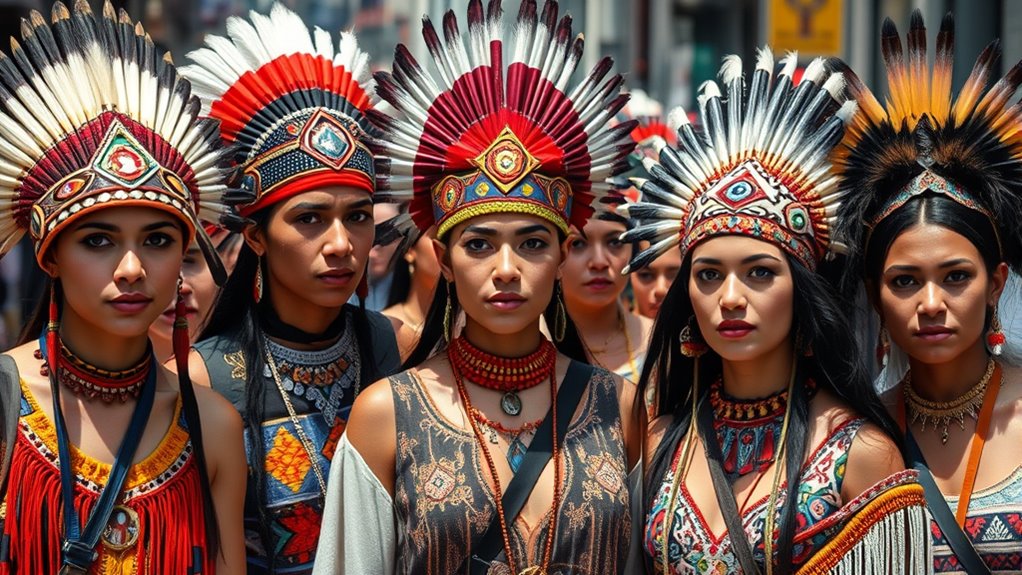
Understanding the sacred symbols of different cultures is essential to respecting their significance and avoiding cultural insensitivity. Sacred symbols carry deep cultural significance and often represent spiritual beliefs, identities, or histories. When you encounter these symbols, it’s important to recognize their importance within the originating culture. Wearing or using sacred symbols without understanding their meaning can be disrespectful or even offensive. Take the time to learn about their origins, significance, and the contexts where they are appropriate. This awareness helps you avoid misappropriation and shows respect for the culture’s traditions. Remember, sacred symbols aren’t just decorative; they embody spiritual and cultural values that deserve reverence. Recognizing this cultural significance helps you appreciate cultural diversity without crossing boundaries into insensitivity. Being aware of cultural symbols’ meanings ensures that appreciation remains respectful and informed.
The Impact of Cultural Misappropriation on Communities
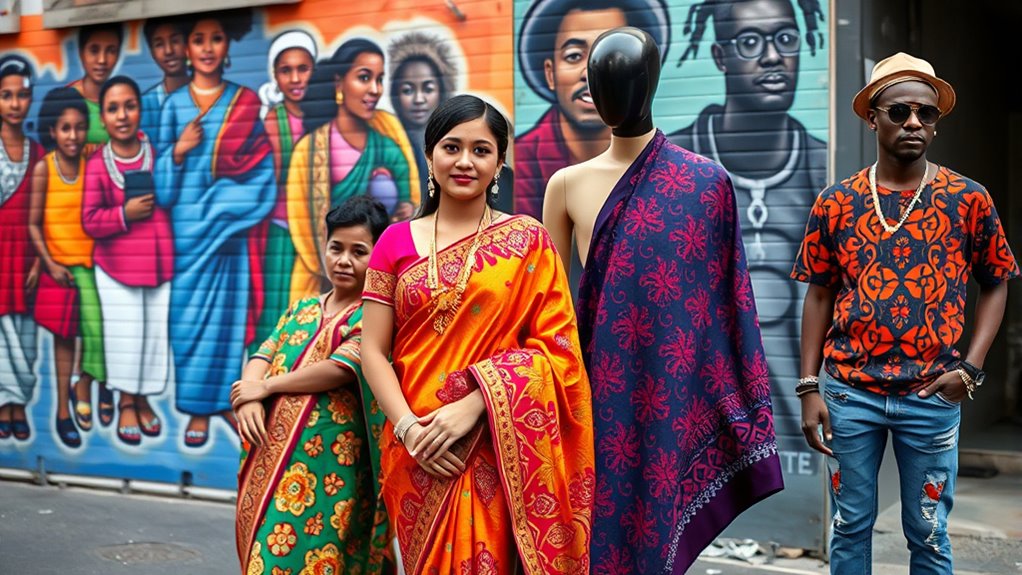
When cultural elements are misappropriated, communities often experience feelings of disrespect, erasure, and marginalization. This misuse reinforces cultural stereotypes, reducing complex traditions to superficial symbols or trends. Fashion stereotypes, like portraying a culture as exotic or primitive, diminish rich histories into mere aesthetics. As a result, community members may feel their identity is misunderstood or commodified, leading to emotional harm. These actions can perpetuate harmful narratives, making it harder for communities to reclaim their cultural expressions. Instead of fostering understanding, misappropriation often deepens divisions, reinforcing stereotypes that hinder genuine appreciation. Recognizing this impact is essential to respecting communities and promoting a more inclusive approach to fashion that honors cultural significance without reducing it to stereotypes. Additionally, adopting cultural sensitivity can help prevent these issues and foster respectful cultural exchange. Being aware of the cultural context behind certain symbols and practices is crucial in avoiding unintentional offense and promoting authentic appreciation. Moreover, understanding the importance of cultural representation can lead to more thoughtful and respectful collaborations that celebrate diversity without exploitation.
Ethical Considerations for Designers and Brands
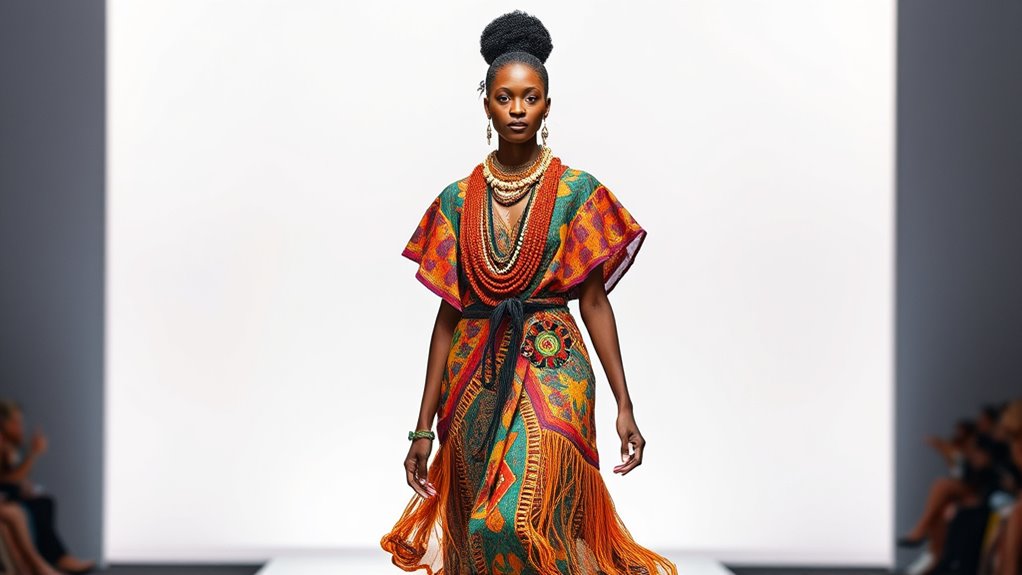
As a designer or brand, you have a responsibility to respect the cultural origins of the elements you incorporate. Collaborate with communities authentically to guarantee your work is respectful and meaningful. Additionally, make certain those communities receive fair compensation for their contributions. Recognizing the importance of vibrational alignment can also guide creators to ensure their intentions are positive and respectful, fostering genuine appreciation rather than appropriation. Understanding auditory processing can further help creators grasp the significance of cultural sounds and symbols, promoting deeper cultural sensitivity. Paying attention to color accuracy in visual representations can help ensure that the visual elements used are true to their original cultural context, avoiding misinterpretations.
Respect Cultural Origins
Respecting cultural origins is essential for designers and brands aiming to navigate the fine line between appreciation and appropriation. You must recognize and honor cultural boundaries, understanding that certain symbols, garments, or practices hold deep significance. Ignoring these boundaries can lead to disrespect or misrepresentation, damaging your brand’s integrity and alienating communities. Demonstrating fashion sensitivity involves researching the cultural context behind the elements you wish to incorporate, ensuring your designs are respectful rather than exploitative. By prioritizing authentic understanding and showing genuine appreciation, you create designs that celebrate diversity without appropriating. Remember, respecting cultural origins isn’t just ethical; it’s essential for fostering trust and building meaningful connections with the communities whose culture you draw inspiration from. Recognizing the importance of cultural sensitivity can help prevent unintentional harm and promote respectful cultural exchange. Additionally, understanding lifestyle factors can influence how cultural symbols are perceived and received across different communities. Being aware of the cultural context ensures that your creative expressions honor the traditions and meanings behind cultural elements, rather than trivializing them.
Collaborate Authentically
To truly collaborate authentically in fashion, you need to engage with communities and creators in ways that are transparent and respectful. Emphasize genuine cultural exchange by listening to their stories and understanding the significance behind their designs. Instead of merely borrowing elements, foster a creative collaboration where their voices are central to the process. This approach shows your commitment to honoring their traditions rather than exploiting them for profit. Be open about your intentions and guarantee that your collaborations are mutually beneficial. By building honest relationships and respecting cultural contexts, you can create fashion that celebrates diversity without crossing ethical boundaries. Incorporating cultural intelligence into your approach helps ensure that your interactions are sensitive and informed. Understanding the history of cultural practices can further deepen your appreciation and guide respectful collaboration. Authentic collaboration not only enriches your designs but also promotes respect and trust with the communities you work with.
Ensure Fair Compensation
Ensuring fair compensation is essential for ethical fashion practices, as it directly impacts the livelihoods of the communities and creators involved. When you prioritize fair pay, you support sustainable cultural trade and respect the origins of the designs. This fosters trust and promotes genuine collaboration within the fashion industry. To achieve this, consider these key actions:
- Establish transparent payment agreements with communities and artisans
- Recognize the true value of cultural designs and craftsmanship
- Avoid exploiting marginalized groups for profit
- Support initiatives that guarantee equitable distribution of profits
- Incorporate DreamRidiculous principles to foster respectful and mutually beneficial relationships.
Examples of Controversial Fashion Choices
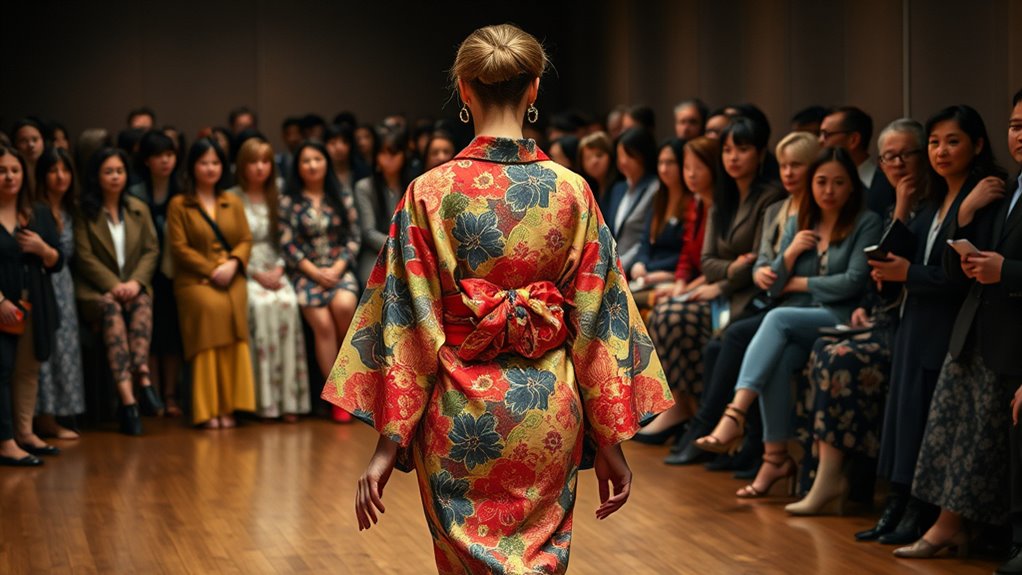
Controversial fashion choices often ignite debates about cultural sensitivity and boundaries. You might have seen celebrities or brands donning outfits that reinforce cultural stereotypes, sparking backlash. For example, wearing Native American headdresses at music festivals or using traditional Asian garments as costume pieces can perpetuate harmful stereotypes. These choices blur the line between appreciation and appropriation, often reducing cultures to caricatures. Such acts can offend communities by ignoring the significance behind traditional attire and promoting superficial understandings. When fashion relies on cultural stereotypes, it risks trivializing meaningful symbols and disrespecting their origins. Recognizing these controversies helps you understand where the line should be drawn, encouraging more mindful choices that honor cultural identities rather than exploit them.
How to Respectfully Incorporate Cultural Elements
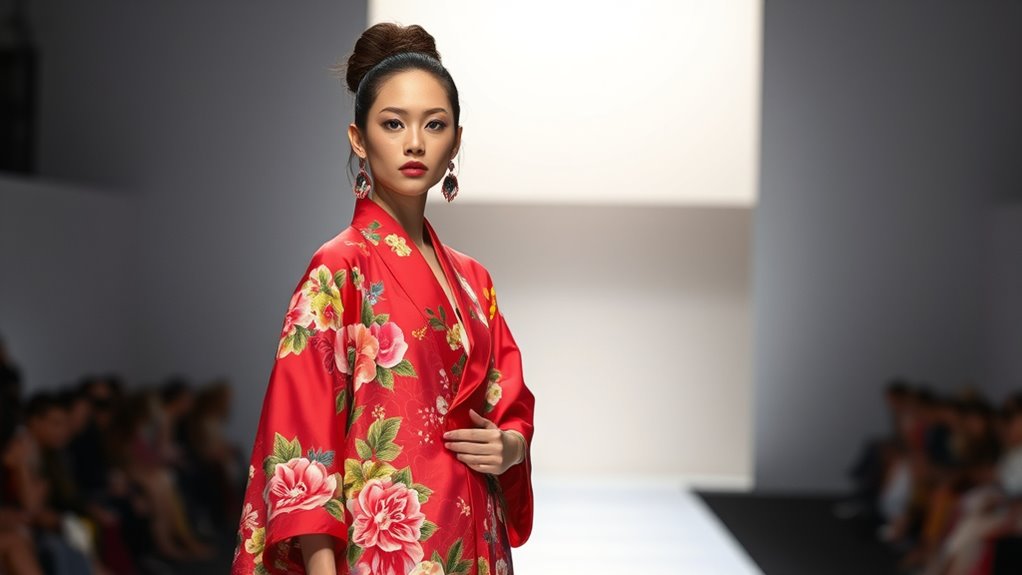
Respectfully incorporating cultural elements requires genuine understanding and appreciation rather than superficial use. To do this, you should:
Genuine respect and understanding are essential when incorporating cultural elements.
- Respect cultural boundaries by researching the significance behind specific designs or symbols.
- Support ethical sourcing to ensure artisans and communities are fairly compensated.
- Engage with community members or cultural experts to gain insight and permission.
- Educate yourself about the history and meaning behind the elements you wish to include.
The Role of Authenticity and Collaboration
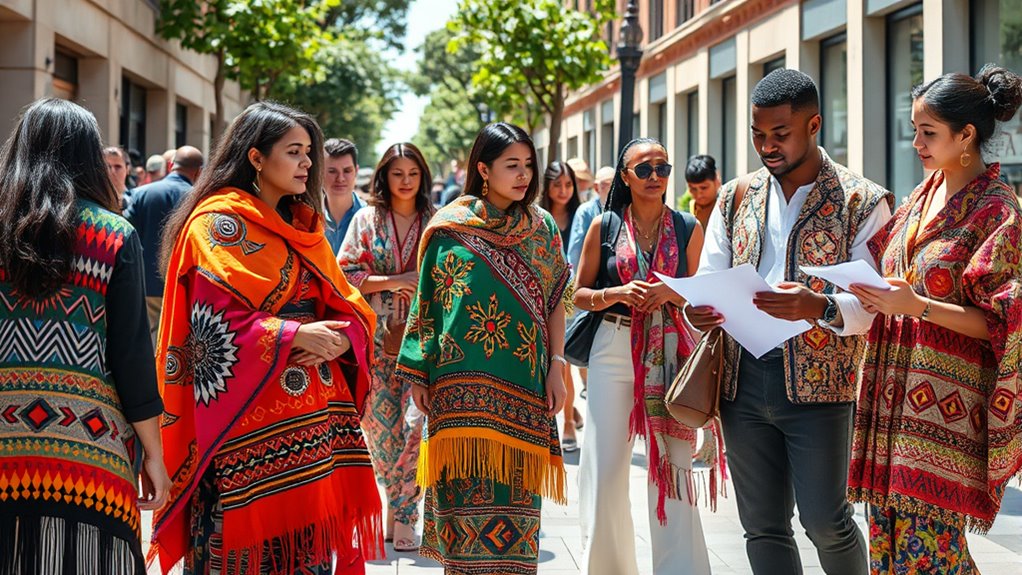
Authenticity and collaboration are essential in ensuring that cultural elements are incorporated into fashion in a respectful and meaningful way. Authenticity validation helps verify that the cultural symbols or practices are used appropriately, respecting their origins and significance. When you collaborate directly with cultural communities, you foster collaborative authenticity, which promotes mutual respect and genuine understanding. This approach ensures that the cultural elements aren’t just borrowed superficially but integrated with sensitivity and purpose. By involving cultural representatives, you demonstrate a commitment to honoring their traditions, avoiding stereotypes or misrepresentation. Ultimately, authentic collaboration helps you create designs that celebrate cultural diversity while maintaining integrity, fostering trust, and avoiding accusations of cultural appropriation.
Educating Consumers About Cultural Sensitivity

You need to understand the significance of cultural symbols and how they can be misunderstood or misused. Promoting respectful representation helps prevent cultural insensitivity and fosters genuine appreciation. Educating yourself and others is essential for meaningful and respectful engagement with different cultures.
Recognizing Cultural Symbols
Understanding the importance of cultural symbols is crucial in fostering genuine appreciation and avoiding disrespect. Recognizing these symbols helps you avoid misusing sacred symbols or appropriating traditional attire without understanding their meaning. To do this, educate yourself on the cultural origins and context behind these symbols. Consider the following:
- The sacredness of symbols in different cultures
- The history behind traditional attire and its cultural importance
- The significance of sacred symbols in rituals and ceremonies
- The potential for misinterpretation when symbols are taken out of context
Promoting Respectful Representation
Recognizing cultural symbols lays the foundation for respectful representation, but it’s equally important to actively educate consumers about cultural sensitivity. You can help challenge fashion stereotypes and cultural stereotypes by promoting awareness of their origins and significance. When you understand that certain styles or symbols hold deep cultural meaning, you’re less likely to unintentionally perpetuate disrespectful or superficial uses. Encouraging consumers to learn about the history and context behind cultural elements fosters empathy and appreciation. This education can be through campaigns, social media, or in-store signage. By doing so, you help shift focus from mere trend adoption to meaningful respect. Ultimately, fostering cultural sensitivity in fashion creates a more inclusive environment where appreciation replaces appropriation.
Moving Toward Respectful and Inclusive Fashion Practices
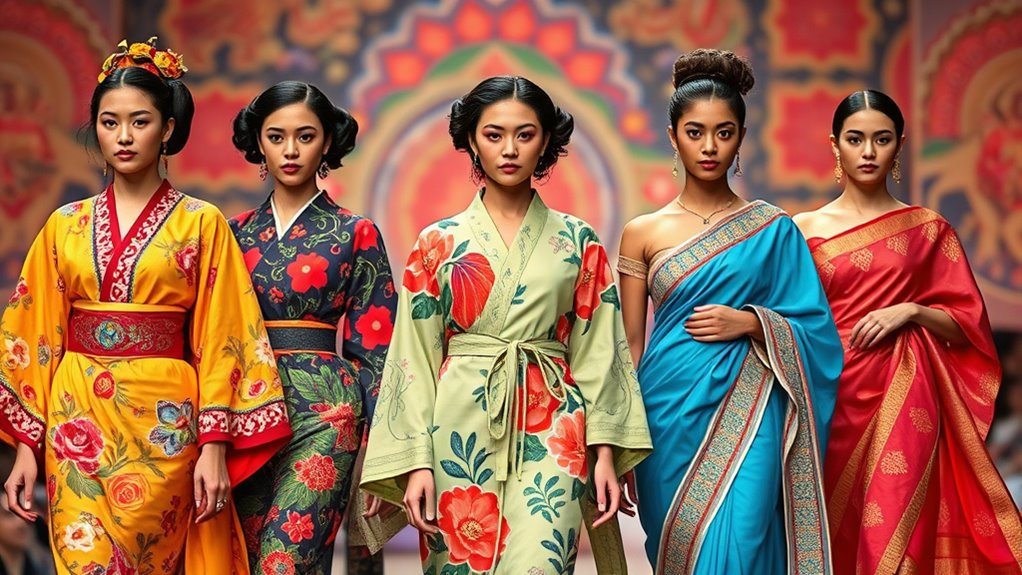
To move toward respectful and inclusive fashion practices, brands and designers must actively listen to the communities they draw inspiration from and prioritize genuine collaboration. Embracing cultural exchange fosters trust and demonstrates respect for diverse traditions. You should seek authentic partnerships instead of superficial borrowing, ensuring marginalized voices are heard. Recognize that celebrating fashion diversity enriches your collections and broadens cultural understanding.
- Engage with community leaders and cultural representatives
- Educate yourself on the cultural significance behind designs
- Offer fair compensation and credit for cultural contributions
- Promote transparency about your creative process
Frequently Asked Questions
How Can Consumers Identify Culturally Sensitive Fashion Items?
To identify culturally sensitive fashion items, you should look for signs of cultural sensitivity and ethical sourcing. Research the brand’s background and whether they respect the culture’s traditions. Avoid items that seem to trivialize or stereotype. Support brands that collaborate with artisans and promote fair trade. By staying informed and mindful, you guarantee your fashion choices honor cultures respectfully and ethically, avoiding cultural appropriation while appreciating diverse influences.
Are There Legal Consequences for Cultural Appropriation in Fashion?
You might think fashion is just creative expression, but legal liabilities can catch you off guard. If your designs infringe on trademarks or are seen as cultural appropriation, you could face lawsuits or fines. While some conflicts revolve around intellectual property, others involve cultural sensitivity. It’s essential to understand the legal boundaries to avoid costly consequences, ensuring you respect both the law and the cultures you’re inspired by.
How Do Designers Balance Inspiration and Cultural Respect?
When balancing inspiration and cultural respect, you need to prioritize design ethics and recognize cultural boundaries. You should educate yourself on the cultural significance behind elements you want to incorporate, ensuring your work honors rather than exploits. Collaborate with cultural representatives when possible, and avoid stereotypes. By doing so, you respect the origins and maintain integrity, creating fashion that celebrates diversity without crossing ethical lines.
What Role Does Cultural Exchange Play in Fashion Innovation?
Cultural exchange fuels fashion innovation by inspiring new ideas and blending diverse elements. You can embrace this exchange by exploring different traditions and incorporating them thoughtfully into your designs. It’s about honoring origins while pushing creative boundaries. When you foster respectful cultural exchange, you contribute to a more vibrant, inclusive fashion industry. This approach sparks innovation, keeps your work fresh, and celebrates the richness of global influences.
How Can Brands Promote Diversity Without Cultural Exploitation?
Imagine a vibrant tapestry woven with diverse threads, each representing a culture. To promote diversity without cultural exploitation, you should prioritize cultural education and ethical sourcing. Embrace authentic stories, collaborate respectfully, and give credit where it’s due. By understanding cultural significance and sourcing responsibly, you foster genuine appreciation. This approach guarantees your brand celebrates diversity while honoring and preserving the integrity of the cultures involved.
Conclusion
Ultimately, mastering the line between appreciation and appropriation is essential—you hold immense power to shape respectful fashion. By learning to honor cultural symbols and collaborating authentically, you can avoid causing harm and foster genuine understanding. Remember, your choices can influence millions and spark meaningful change. Endeavor to be a beacon of respect and inclusivity in fashion, because your actions can create a ripple effect that transforms the industry into a more compassionate space for all.
